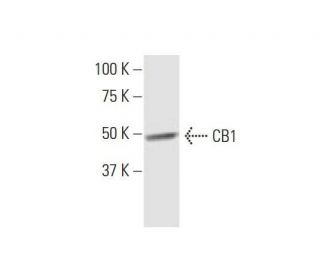


CB1/Cannabinoid Receptor 1/CNR1 Antibody (2F9): sc-293419
- CB1/Cannabinoid Receptor 1/CNR1 Antibody (2F9) is a mouse monoclonal IgG2b κ CB1/Cannabinoid Receptor 1/CNR1 antibody, cited in 13 publications, provided at 100 µg/ml
- raised against amino acids 1-110 representing recombinant partial length CB1 of human origin
- recommended for detection of CB1 of mouse, rat and human origin by WB, IP and ELISA
- m-IgG Fc BP-HRP and m-IgG2b BP-HRP are the preferred secondary detection reagents for CB1/Cannabinoid Receptor 1/CNR1 Antibody (2F9) for WB applications. These reagents are now offered in bundles with CB1/Cannabinoid Receptor 1/CNR1 Antibody (2F9) (see ordering information below).
QUICK LINKS
SEE ALSO...
CB1 Antibody (2F9) is a mouse monoclonal IgG2b kappa light chain antibody that detects CB1 protein of mouse, rat, and human origin by western blotting (WB), immunoprecipitation (IP), and enzyme-linked immunosorbent assay (ELISA). Anti-CB1 antibody (2F9) is available as a non-conjugated format. CB1, also known as cannabinoid receptor 1, is a G-protein coupled receptor predominantly expressed in the brain, where CB1 plays a crucial role in modulating neurotransmitter release and influencing various physiological processes. CB1 localization in the central nervous system is particularly important as CB1 is involved in the regulation of pain, mood, appetite, and memory, making CB1 a significant target for therapeutic interventions in conditions such as chronic pain, anxiety, and neurodegenerative diseases. CB1 undergoes post-translational modifications, including phosphorylation, which can affect CB1 activity and interactions with other proteins. Phosphorylation at serine 316 disrupts CB1 -mediated inhibition of calcium channels, thereby influencing neuronal excitability and signaling pathways. This intricate regulation underscores CB1 importance in maintaining homeostasis within the nervous system and highlights CB1 potential as a target for drug development aimed at modulating cannabinoid effects.
Alexa Fluor® is a trademark of Molecular Probes Inc., OR., USA
LI-COR® and Odyssey® are registered trademarks of LI-COR Biosciences
CB1/Cannabinoid Receptor 1/CNR1 Antibody (2F9) References:
- Evidence that 2-arachidonoylglycerol but not N-palmitoylethanolamine or anandamide is the physiological ligand for the cannabinoid CB2 receptor. Comparison of the agonistic activities of various cannabinoid receptor ligands in HL-60 cells. | Sugiura, T., et al. 2000. J Biol Chem. 275: 605-12. PMID: 10617657
- The endogenous cannabinoid system and brain development. | Fernández-Ruiz, J., et al. 2000. Trends Neurosci. 23: 14-20. PMID: 10631784
- Reduction of stress-induced analgesia but not of exogenous opioid effects in mice lacking CB1 receptors. | Valverde, O., et al. 2000. Eur J Neurosci. 12: 533-9. PMID: 10712632
- Molecular cloning of a human cannabinoid receptor which is also expressed in testis. | Gérard, CM., et al. 1991. Biochem J. 279 (Pt 1): 129-34. PMID: 1718258
- Development of radioligands for in vivo imaging of type 1 cannabinoid receptors (CB1) in human brain. | Horti, AG. and Van Laere, K. 2008. Curr Pharm Des. 14: 3363-83. PMID: 19075713
- Signal transduction of the CB1 cannabinoid receptor. | Turu, G. and Hunyady, L. 2010. J Mol Endocrinol. 44: 75-85. PMID: 19620237
- Structure of a cannabinoid receptor and functional expression of the cloned cDNA. | Matsuda, LA., et al. 1990. Nature. 346: 561-4. PMID: 2165569
- Cannabinoid CB1 Receptor Deletion from Catecholaminergic Neurons Protects from Diet-Induced Obesity. | Srivastava, RK., et al. 2022. Int J Mol Sci. 23: PMID: 36293486
- Molecular characterization of a peripheral receptor for cannabinoids. | Munro, S., et al. 1993. Nature. 365: 61-5. PMID: 7689702
- Molecular cloning, expression and function of the murine CB2 peripheral cannabinoid receptor. | Shire, D., et al. 1996. Biochim Biophys Acta. 1307: 132-6. PMID: 8679694
- Protein kinase C disrupts cannabinoid actions by phosphorylation of the CB1 cannabinoid receptor. | Garcia, DE., et al. 1998. J Neurosci. 18: 2834-41. PMID: 9526000
- Unresponsiveness to cannabinoids and reduced addictive effects of opiates in CB1 receptor knockout mice. | Ledent, C., et al. 1999. Science. 283: 401-4. PMID: 9888857
Ordering Information
| Product Name | Catalog # | UNIT | Price | Qty | FAVORITES | |
CB1/Cannabinoid Receptor 1/CNR1 Antibody (2F9) | sc-293419 | 100 µg/ml | $316.00 | |||
CB1/Cannabinoid Receptor 1/CNR1 Antibody (2F9): m-IgG Fc BP-HRP Bundle | sc-540290 | 100 µg Ab; 10 µg BP | $354.00 | |||
CB1/Cannabinoid Receptor 1/CNR1 Antibody (2F9): m-IgG2b BP-HRP Bundle | sc-549784 | 100 µg Ab; 10 µg BP | $354.00 |
